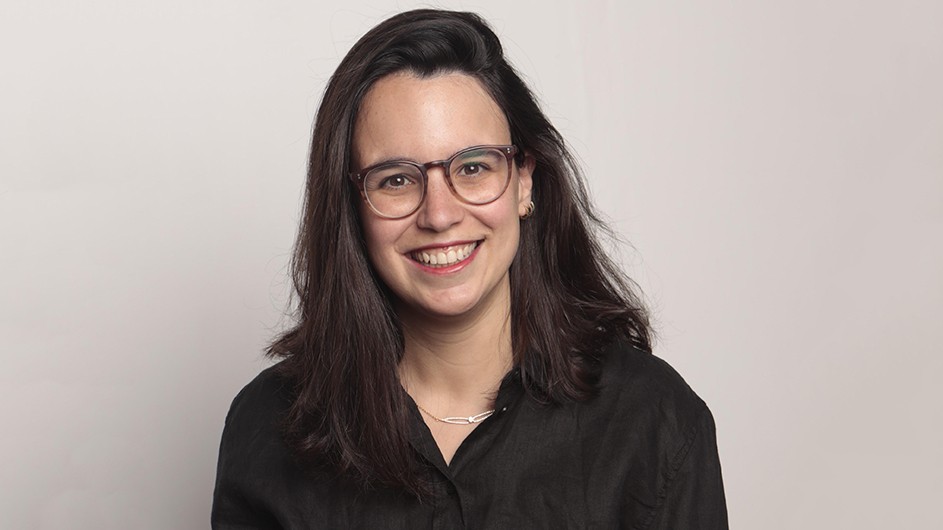Finding the Beauty in Condensed Matter Physics
Raquel Queiroz, a new assistant professor at Columbia, is setting her own rules as she explores the science of solid materials.
No matter how much a donut is squished or flattened, the number of holes in it cannot be changed without altering its fundamental identity as a donut. In physics, the study of such immutable characteristics is called topology, explained Raquel Queiroz. “It’s quantities that characterize geometric spaces that cannot be changed by deformation, so they're very robust,” she said.
That robustness can be found in many of the materials that surround us; Queiroz joined Columbia this month to find topology in the world, and to figure out what to do with it.
The Path to Condensed Matter
Queiroz grew up in Portugal, the daughter of a painter who encouraged her sense of wonder about the world. “I was always asking, ‘why,’ ‘why,’ ‘why,’” she recalled.
As she grew up, she saw two paths: “You either create art, or you try to understand nature,” she said. “I realized I’m a bit better at observing.”
Peel back enough layers when looking at nature, and you’re left with physics: a subject that Queiroz finds as beautiful as it is fascinating.
She earned an undergraduate degree from Instituto Superior Tecnico in Lisbon, in 2009, before moving to Imperial College London to complete her master’s. Her thesis was on hypothetical elementary particles called magnetic monopoles and how they could influence electric charge—her first introduction to the role of topology in defining basic phenomena in nature.
To understand the world, however, it’s not enough to just understand the nature of fundamental particles. The rules change when one particle combines with millions and billions of others. A single molecule of water, for example, follows different physical laws than billions of water molecules in a moving wave, she said.
From London, she moved to the Max Planck Institute for Solid State Research in Stuttgart, where she completed her PhD under Andreas Schnyder in 2015. There, she shifted her attention to condensed matter physics, a discipline focused on the fundamental properties of billions of particles interacting with each other in solid materials. “I wanted to see how physics plays out in things I can see, in experiments on tabletops and in the lab,” she said. She continued her condensed matter work as a researcher at the Weizmann Institute of Science near Tel Aviv, before accepting a position as an assistant professor of physics at Columbia last year.
“She is an expert in the ways in which the abstract notion of topology manifests itself in the electronic properties of real materials,” said her former group leader at the Weizmann Institute, physicist Ady Stern. “She spans the entire spectrum: from the mathematics, to computer calculations of band structure, to the effects of interaction between electrons, and finally to the understanding of experimental data."
For Queiroz, materials are the perfect playground for theoretical physics because you get to choose the rules: What atoms will make up your crystal lattices, and how will you layer different materials together? What defects will you introduce? Each of those variables characterizes the topology of the system, and the physics that result.
"Physics is very beautiful because nature is very beautiful,” said Raquel Queiroz. “And how else can you understand nature?"
Playing in the Physics Playground
Once the rules are set, it’s time to start playing. "All kinds of weird stuff happens when you have topological features in materials,” Queiroz said. While much of her work in topology is theoretical, practical applications abound. For example, if an insulator—a material that does not conduct electricity—is stretched out, it will become a metal before its atomic bonds are broken entirely. That topological feature could potentially be tapped to build one-dimensional wires that perfectly conduct electricity, an advance that could eliminate energy loss from today’s inefficient electronic devices.
Topological materials might also prove useful in quantum computers. Such devices have the potential to be faster and more powerful than classical computers because their constituent quantum bits, or qubits, take advantage of two properties of quantum states—superposition and entanglement—to encode information. Those quantum states, however, are fragile and suffer from an issue called decoherence: when perturbed, they fall out of sync, and the information the qubits hold is lost. Because topological materials are robust and resist perturbation, they could one day be used to build longer-lasting qubits, Queiroz explained.
With so many possible materials in nature, the challenge for physicists is deciding what ingredients to combine and how. “You can write a model and then show it to experientialists, and they will actually see it happen,” she said. And when things don’t go as planned? That’s a defect or a new way of stacking or twisting or punching holes into the system to incorporate back into the theoretical models. “It’s all about having creative ideas and just looking,” Queiroz said.
Her colleagues at Columbia are excited to add another theoretical physicist to the mix. “Her interests and expertise connecting topology, interactions, and randomness to the properties of materials, both naturally occurring and yet to be designed, add an essential new dimension to our research,” said theoretical physicist Andrew Millis.
Beyond the Blackboard
Joining Queiroz in the move from Israel are her 9-month-old son, her husband, and his 5,000 records. The perfect soundtrack for thinking about topology—or not—is always ready to play. In the coming months, Queiroz will be recruiting group members, finding collaborators from across Columbia, and getting ready to start teaching a new generation of physicists. All while enjoying the city, its art, its music (of course), and attempting to answer those tricky questions about topology.
That curiosity about nature that her family instilled in her years ago now drives her forward. "In the end, physics is very beautiful because nature is very beautiful,” Queiroz said. “And how else can you understand nature?"

